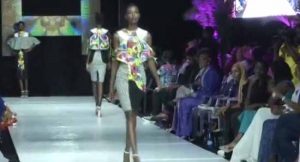
Senegalese designer, Lahad Gueye was one of a record 36 designers at the event this year.
With a master’s degree in economics and an acclaimed distinct style, Gueye has the ideal combination for the fashion business.
But like many designers on the continent, he struggles to navigate an industry that is admired but does not get enough financial attention. Fashion lives in the shadows of more established sectors like mining and commodities in Africa.
“When it comes to creativity and imagination, it’s all there. But the problem is that fashion is not organised in Africa. It needs to be said. We have to say things as they are. We really have imagination, we really know how to create, we have the talent and everything but we need the organisation and I think talent without organisation, at my level, it can’t get you very far,” Guye said.
Yet the African Development Bank (AfDB) says fashion and other creative industries if properly financed and exploited can create jobs for the 13 million joining the labour market every year, accelerate economic growth, industrialisation and enhance trade.
Economist Emanuela Gregorio, who helped set up the AfDB’s ‘Fahionomics’ initiative in 2016 says countries in east and southern Africa are showing that the potential is real.
She said, “These are great examples because they demonstrate that both public and private sector are coming together because they see a great potential of the sector when it comes to textile fashion designers. They use creativity as their unique selling point. But creativity is not enough. You need to develop the business skills of the target group. We need to capitalise on this,”.
Ethiopia textile and apparel sector have grown by an average 51 percent in last 5 – 6 years, but on the world scale, apparel exports from Africa represent less than one percent.
Adama Ndiaye, the founder of Dakar Fashion Week is a successful West African designer with her own label – Adama Paris, and a fashion TV channel.
She sells her creations worldwide including New York, Paris and Osaka but she says it’s still extremely hard to make it in fashion in Africa and harder still to compete with international designers.
Ndiaye wants investors to take fashion more seriously and for governments to work harder on improving the infrastructure from giving better training, to building industry and investing in cost-efficient transport.
She said, “You don’t want to take un-calculated risks in business. You need a base, you need a frame and in this industry we are the ones making the base and the frame and even the pyramid on top and it turns into a bit of a circus and that is why we need to ‘look up’ to countries in South Africa and in the East Africa who have an established structure, and people like me can graft themselves onto the structure and add value,”.
There are also very few industrial spaces for the fashion designers to move out of the workshop and into mass production.
The Fashionomics report said Africa currently accounts for just 1.9 of global manufacturing.
Ndiaye hopes her business will expand once she moves production to Senegal’s new industrial complex, but still, a lot more needs to be done, especially in appreciating and investing in building the industry as a whole in African countries.
“Those countries that have specialised loans have a more dynamic fashion and a fashion industry that is more “out there” than us. We don’t have an Elle magazine here, we don’t have Vogue, and we don’t have Marie Claire here. What I defend is the ‘African Dream’ so we start making our own press.
“Just like I created the television channel Fashion Africa with the slogan ‘Made in Africa’ that others create television channels, that we create our own magazines. We don’t have to copy Europe or France or to have Elle or Vogue but we can have the equivalent that is relevant to us,” Ndiaye said.
Gregorio says the fastest way to get the industry going is to help finance Small and Medium-sized Enterprises (SMEs).
He said, “The (SMEs) are the ones that are stimulating 80% of employment on the continent and that’s the way to go: focusing on developing the skills of these industries and help them to grow their business, to be able to serve locally, regionally, and also reach global value chains,” Gregorio said.
Fifteen years after the first African catwalk in Dakar the creative industry is looking up.
Labour costs are rising in Asia and the sub-Saharan countries face a real opportunity to take up the mantle and stride towards its own industry success.
The designers say they are ready. It is now up to investors to pick up the challenge and governments to build the infrastructure the sector needs to turn the potential into reality.

